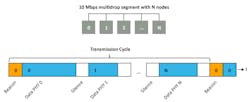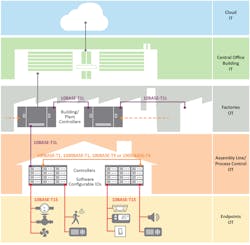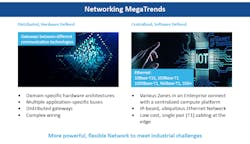Single-Pair Ethernet Comes Just in Time
What you’ll learn:
- How the standard brings Ethernet to the very edge of the network.
- Why it fits neatly with the trend toward zonal architecture.
- How it will reduce wiring complexity and vehicle factory automation.
The world is awash in data-communication protocols, with most of them designed to deliver the highest possible data rates. However, the vast majority of devices, such as switches and actuators, are simple, don’t produce massive amounts of data, and thus don’t require high-speed communications. There are billions of them worldwide and their numbers are growing exponentially.
What’s been needed for some time is a single, simple, low-cost data-communication solution that can serve all of these devices in industrial, automotive, and other markets. The solution appeared in late 2019 in the form of the IEEE’s 802.3cg standard. As we’ll see, it has immense potential because it brings low-cost, single-pair Ethernet cabling to the edge of the network.
The initiative for the standard came from an IEEE task force studying how to provide a low-speed technology that could cover very long distances and deliver a data rate of 10 Mb/s over a single, balanced pair Ethernet cable. In addition, there was a desire to have multidrop capabilities over shorter distances. Although 10 Mb/s doesn’t sound impressive, it’s more than enough to control a switch, relay, actuator, or robot arm and many other devices, and at the time, “Industrial Ethernet” had no version that could provide these capabilities in a cohesive manner.
Automakers in the task force requested a shorter-reach solution with the same basic capabilities along with multidrop capability, in which each node connects to a single cable. It thus eliminates the need for a switch and requires fewer lines, switch ports, and transceivers. This version would use Ethernet for everything, from the lowest to the highest speeds.
In the end, almost everyone got their wish, which resulted in Ethernet 10BASE-T1S for distances up to at least 25 m and 10BASE-T1L that covers up to 1 km. They joined 100BASE-T1 and 1000BASE-T1 in the family collectively known as single-pair Ethernet (SPE). The transmission medium ranges from a single twisted pair of wires to other wire-pair configurations and parallel traces on a printed circuit board (PCB) or server backplane. All are easier to install, lighter, more flexible, and less costly than alternatives (see table).
The Basics
Other than their maximum transmission distances, two primary differences exist between 10BASE-T1S and 10BASE-T1L. First, only 10BASE-T1S offers multidrop as well as point-to-point connection ability. The second is that only 10BASE-T1S employs Physical Layer Collision Avoidance (PLCA), which is a key ingredient when used in real-time applications that require deterministic performance such as automotive, industrial, and building automation (Fig. 1).
PLCA is designed for half-duplex, multidrop networks such as 10BASE-T1S. It eliminates the problems with Carrier Sense Multiple Access with Collision Detection (CSMA/CD) in multidrop mixing segments.
CSMA/CD can exhibit random latencies caused by data collisions. PLCA provides guaranteed maximum latency and other characteristics that overcome these limitations. With PLCA in place, the transmission cycle begins with a beacon sent by a coordinator node (Node 0) that the network nodes use to synchronize.
After the beacon is sent, the transmit opportunity passes to Node 1. If it has no data to send, it yields its opportunity to Node 2, and so on, with the process continuing until each node has been offered at least one transmit opportunity. A new cycle is then initiated by the coordinator node, which sends another beacon.
To prevent a node from blocking the bus, a jabber function interrupts a node’s transmission if it exceeds its allotted time, allowing the next node to transmit. The result is that there’s no impact on data throughput and no data collisions on the bus.
Both solutions have considerable benefits, not the least of which is that Ethernet is globally ubiquitous in both the information technology (IT) and operational technology (OT) worlds, is well-understood, and is supported by hundreds of companies. Its cost is relatively low and decreasing, and it has maintained its core structure through every iteration from inception. This means that when Ethernet is the primary communication protocol used in a system, there’s no need for protocol conversion and the gateways required to perform it.
Every kind of device can be supported without conversion, from the simplest low-data-rate switch to high-data-rate sensors such as cameras that produce vast amounts of data and require gigabit-per-second speeds. They can all be aggregated in an Ethernet switch and sent on to the cloud at Ethernet’s highest data rates for processing and analysis (Fig. 2).
Rewards for Automakers
Settling on a single protocol for most functions has monumental benefits for automakers faced with supporting not just the CAN bus, but multiple application-specific standards. Every model year brings enhancements to advanced driver-assistance systems (ADAS) systems, often requiring new cameras, radar, ultrasound sensors (and LiDAR in the future), as well as changes to infotainment and navigation systems.
The result is that in today’s vehicles, it’s not uncommon to have 40 different wiring harnesses, 80 to 100 electronic control units (ECUs), and 300 wires that collectively span 2.5 miles and weigh up to 250 lb. The multiple types of cables required for various applications also present electromagnetic-compatibility (EMC) challenges as each one has its own requirements.
To meet the demands of cars that will soon employ hundreds of millions of lines of code compared with 100 million lines today, the industry is transitioning to an Ethernet-based zonal electronic/electrical (E/E) architecture that aggregates sensors into a single link from the zonal gateway to a backbone (Fig. 3).
It’s based almost entirely on Ethernet, whose plug-and-play capabilities are uniquely suited to the service-oriented environments that will define vehicles in the future. Devices can be connected and disconnected in real-time, with no downtime—a significant advantage over CAN buses. That said, the CAN bus has served the auto industry well for many years and it continues to do so for those applications for which it’s best suited, so it will likely be retained for years.
An Industrial Solution
Although the auto industry stands to benefit most from 10BASE-T1S, the industrial sector can benefit substantially from 10BASE-T1S and 10BASE-T1L for several reasons. First, industrial facilities use many different communication technologies to interconnect devices, from I2C to RS-485, UARTs, and CAN, and they connect everything from control cabinet wiring to temperature sensors, HVAC actuators, elevators, fans, voltage monitors, dc-dc converters and other modules, and computer backplanes. Many of these devices require only low data rates that the standards are designed to serve.
Although it’s not yet a major topic of discussion, it can play a key role in IoT by connecting devices that would otherwise use one of the various short-range wireless solutions such as Zigbee, Bluetooth, or Wi-Fi. As many early adopters have learned, making wireless “work” for IoT is easier said than done. These solutions will obviously play an immense role in industrial IoT, but they needn’t be the only solution considering Ethernet’s benefits.
Next, 10BASE-T1S multidrop capability enables many devices to be connected, removed, or replaced without affecting overall network performance, and the process is very simple. Finally, Ethernet is invariably already present in almost every facility, so moving outward from the cloud to the edge can be accomplished with a single standard. It’s also important to note that as industry moves to its fourth generation, the zonal approach is being applied in this market, too, and Ethernet is the chosen solution. There are other benefits, but these alone make SPE very appealing.
The First Transceiver
Implementing 10BASE-T1S requires Ethernet transceivers that support it. The first of these, which serves 10BASE-T1S, is Microchip’s LAN867x family of Ethernet transceivers. The LAN8670/1/2 allows for the creation of both multidrop and point-to-point network topologies. Point-to-point link segments of up to at least 15 m are supported and multidrop mode supports up to at least eight transceivers connected to a common mixing segment of up to 25 m.
Note that these are “minimum maximum” in the IEEE specifications. More nodes and longer distances are possible when system implementers verify proper operation. The transceiver operates from a single 3.3-V dc supply and has an integrated 1.8-V dc regulator. It can be used in harsh environments as its temperature range is −40 to +125°C, and is compliant with industrial EMC and EMI requirements.
The LAN8670/1/2 supports communication with an Ethernet MAC via standard MII/RMII interfaces, and an integrated serial-management interface provides fast register access and configuration at up to 4 MHz. Access to the physical medium is managed by CSMA/CD or by PLCA, allowing for high bandwidth utilization by avoiding collisions on the physical layer and burst mode for transmission of multiple packets for high-packet-rate, latency-sensitive applications.
To give designers an easy way to move into 10BASE-T1S, the company offers RMII and MII evaluation boards that fit on many Microchip MCU boards, or they can be in designs created by the user. Another evaluation board can be plugged into a USB host to make it a 10BASE-T1S node, and it’s supplied with drivers for both Linux and Windows. In addition, the company’s MPLAB Harmony Development Framework includes support to integrate 10BASE-T1S technology with its microcontrollers and microprocessors.
Summary
The release of IEEE’s 802.3cg SPE standard could not have come at a better time, as Industry 4.0 begins to take shape. Industry 4.0 and the auto industry are racing toward simplifying their massive connectivity problem while also adding more sensors and other connectable devices every year.
Both 10BASE-T1S and 10BASE-T1L pave the way for extending the reach of Ethernet to the edge of the network, providing support for low-data-rate devices that have no need for gigabit speeds using simple two-conductor cables. In short, it has the potential to dramatically change the way these devices are connected in both industrial settings and every type of vehicle.




